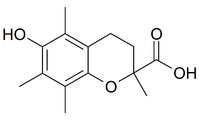Trolox
 | |
| Names | |
|---|---|
| IUPAC name
6-Hydroxy-2,5,7,8-tetramethylchroman-2-carboxylic acid | |
| Identifiers | |
| 53188-07-1 | |
| ChEBI | CHEBI:82625 |
| ChEMBL | ChEMBL153 |
| Jmol-3D images | Image |
| PubChem | 40634 |
| |
| Properties | |
| Molecular formula |
C14H18O4 |
| Molar mass | 250.29 g·mol−1 |
| Except where noted otherwise, data is given for materials in their standard state (at 25 °C (77 °F), 100 kPa) | |
| | |
| Infobox references | |
Trolox (6-hydroxy-2,5,7,8-tetramethylchroman-2-carboxylic acid) is a water-soluble analog of vitamin E sold by Hoffman-LaRoche. It is an antioxidant like vitamin E and it is used in biological or biochemical applications to reduce oxidative stress or damage.
Trolox equivalent antioxidant capacity (TEAC) is a measurement of antioxidant strength based on Trolox, measured in units called Trolox Equivalents (TE), e.g. micromolTE/100 g. Due to the difficulties in measuring individual antioxidant components of a complex mixture (such as blueberries or tomatoes), Trolox equivalency is used as a benchmark for the antioxidant capacity of such a mixture. Trolox equivalency is most often measured using the ABTS decolorization assay.[1] The TEAC assay is used to measure antioxidant capacity of foods, beverages and supplements. Ferric reducing ability of plasma (FRAP) is an antioxidant capacity assays which uses Trolox as a standard.
Oxygen radical absorbance capacity (ORAC) used to be an alternative measurement, but the United States Department of Agriculture (USDA) withdrew these ratings in 2012 as biologically invalid, stating that "The data for antioxidant capacity of foods generated by in vitro (test-tube) methods cannot be extrapolated to in vivo (human) effects and the clinical trials to test benefits of dietary antioxidants have produced mixed results. We know now that antioxidant molecules in food have a wide range of functions, many of which are unrelated to the ability to absorb free radicals" [2]
Notes
- ↑ R.; Pellegrini, N.; Pannala, A.; Yang, M.; Rice-Evans, C. Antioxidant activity applying an improved ABTS radical cation decolorization assay. Free Radical Biol. Med. 1999, 26, 1231-1237
- ↑ USDA "Withdrawn: Oxygen Radical Absorbance Capacity (ORAC) of Selected Foods, Release 2 (2010)". United States Department of Agriculture, Agricultural Research Service. 16 May 2012. Retrieved 13 June 2012.